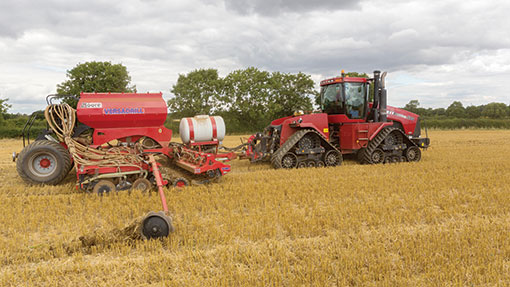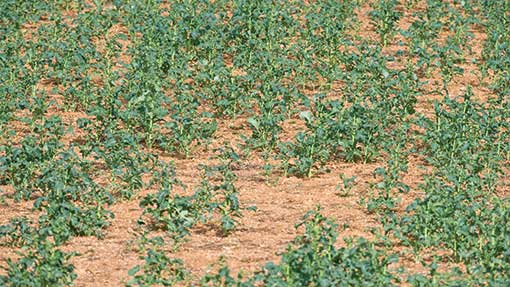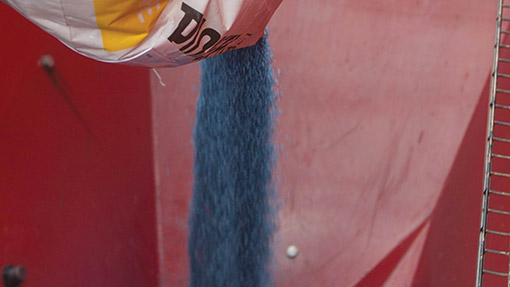Oilseed rape crops face high pest threat without neonicotinoids

The UK oilseed rape crop has flourished over the years – gathering momentum as one of the most profitable break crops available. But growers this autumn face a challenge to establish the crop without one of the favoured seed treatments.
It’s a far cry from 2010, when rape prices smashed through the £400/t barrier and growers were exceeding the 5t/ha marker, prompting a sea of yellow across the country as farmers cashed in on the crop.
Fast-forward to 2014, and oilseed rape has seen a dip in prices. At the same time, the neonicotinoid seed treatment used to help establish more than 90% of the country’s oilseed rape crop has been banned – for two years at least.
The European Commission voted to restrict the use of the seed treatment due to its possible threat to bee health. In doing so, Brussels has stoked fears that crops will be at the mercy of greater pest pressure due to the lack of a decent alternative.
Neonicotinoids now under review include clothianidin, thiamethoxam and imidacloprid, previously used in the seed treatments Cruiser OSR, Modesto and Chinook to provide vital protection against flea beetles and aphids.
Following the ban, the HGCA released research review No.77 looking at the implications of the restriction. It calculated that the total annual cost to the UK industry was approximately £72m.
This season has seen more than 700,000ha of OSR sown. But this autumn is the first that growers will be unable to use the seed treatment. Maximising early establishment will be key in the absence of the seed dressings, say some experts.
Pest threat
The pest problem is now looming large, warns entomologist and crop protection expert Alan Dewar of Dewar Crop Protection. The lack of a viable alternative to tackle problematic pests could see some growers come unstuck this season, he adds.
Be flexible about variety choice
If variety choice is not dictated by seed coming from the Continent, there are a number of options in the UK.
The Limagrain variety Amalie could provide growers with a useful tool in the battle against TuYV. It is the first commercial variety with single-gene resistance, which can still get infected, but at much lower levels.
The short, stiff variety also has good resistance to other diseases such as light leaf spot and stem canker, and may prove useful with fungicide treatments also coming under pressure this year.
Overall variety choice should still be centred around the best-yielding varieties on the Recommended List (RL), according to Niab Tag oilseeds and pulse specialist Simon Kightley.
With one-quarter of the market made up of the top-selling varieties PR46W21 and DK Cabernet, Mr Kightley says these tried-and-tested varieties will once again provide growers with some of the best options, but there are also exciting ones coming through.
This year’s RL has been dominated by varieties that are in their first or second year of testing, so it could be a big year from them to confirm their performance, he says.
DSV’s hybrid Incentive is one stand-out variety that took top spot on the east and west and the north RL, with a gross output of 105% in the east and west list.
Charger also offers an attractive option, according to Mr Kightley, who highlights that it’s a good, short, stiff, early-flowering variety.
Meanwhile, Trinity performed well last year and is only a fraction behind the best this year, while Harper offers a good option with a gross output of 103% and a nine rating for stem canker.
“If growers want to wait until late in the day to get their seed, they will soon be seeing another set of harvest data which will either confirm or deny a lot of the newcomers’ position on the RL.”
Mr Kightley says growers opting to increase seed rates of the cheaper, open-pollinated varieties to battle pest problems will need to be wary of the risk of lodging.

Cabbage stem flea beetles (Ceutorhynchus assimills) will provide the first wave of attack on UK crops, feeding on oilseed rape cotyledons and early true leaves, giving distinctive “shot-holing”, says Dr Dewar.
“If crops get off to a poor start, and conditions are right, they can cause severe damage and even plant loss, which will also make the plants more susceptible to other pests such as pigeons.”
From a financial point of view, growers will need to be more watchful of larvae damage, which can migrate up the stem and damage the growing point of the plant, says Dr Dewar.
Turnip yellows virus (TuYV)-carrying peach potato aphid (Myzus persicae) come later in the autumn. Symptoms often occur towards the end of spring. They include interveinal yellowing of leaves and a red purpling of leaf margins.
The average yield loss from TuYV in untreated crops is 15%. But yield losses of up to 30% can occur where there are severe infections.
Lack of seed treatments will see a sharp rise in foliar-applied pyrethroid insecticides as growers look to protect crops in the early stages where the neonicotinoids previously gave protection.
This will be a cause for concern, warns Dr Dewar, who says increasing selection pressure could see UK cabbage stem flea beetles take the same route as populations in Germany with pyrethroid resistance.
Anecdotal evidence of resistance is already reported in Cambridgeshire. Dr Dewar is certain there is more about. This year will amplify these problems, and growers fear the efficacy of pyrethroids such as cypermethrin and lambdacyhalothrin will quickly drop.
Meanwhile, with almost 100% of peach potato aphids now resistant to pyrethroids and pirimicarb, there is only one registered option available in the form of Plenum (pymetrozine), says Dr Dewar.
This gives protection for up to three weeks, with a cut-off date at GS26, so growers will be able to use it during the important September and October period in a bid to prevent yield losses.
Bayer is also working hard to get thiacloprid – in the form of Biscaya – approved for an autumn foliar application.
Applications can be made in the spring against pollen beetles, but efforts are being made to extend that to another application in the autumn, to give control of cabbage stem flea beetles and aphids.
With aphid numbers already unusually high in sugar beet and potato crops, growers will need to be vigilant in the early autumn and identify what they have in their crop, with host plants and conditions being pivotal.
Dr Dewar suspects farmers in vegetable-growing areas, particularly around the Wash, could be most at risk, with plenty of host plants available. He urges monitoring with water traps and using Rothamsted Research’s insect bulletins.
It is imperative this year to find out if the cabbage stem flea beetles are resistant. Dr Dewar urges growers to get involved in surveys that will be carried out this summer.
Fungicide
The pest threat will be accompanied with an increased disease risk, with growers also losing the fungicide components such as the metalaxyl-M in Syngenta’s Cruiser.
The fungicide element is not registered for use on its own, and with no foliar sprays available to tackle it, fears are growing particularly in the northern region of the country.
Later-sown or backward crops in wet conditions will be most susceptible to infection, which can result in seedling loss and sub-optimal establishment.
Syngenta’s Gary Jobling suggests the threat has taken a back seat to concerns about pests. “But growers should not take it lightly and will have to factor it in when considering when to drill this year,” he warns.
“If you are drilling early, you are reducing the threat of downy mildew, but increasing the amount of time it is at risk from other pests, so it will be a balancing act,” says Mr Jobling.
Alternative treatments
There is hope for growers still looking to use seed treatments from across the Continent, as EU rules allow treated seed to be imported, as long as it is treated where the product is registered.
“This is something that maize growers have done for quite some time,” explains Mr Jobling. Countries such as Denmark still provide options such as tefluthrin to help tackle pests in oilseed rape.
There could also be an alternative seed treatment on the horizon for UK growers. Bayer is pursuing the approval of the methiocarb-based Mesurol (as Crops went to press) – a treatment that has been used in France for a number of years.
Seed already treated in France with Mesurol is available to growers and may be an option should the approval in the UK fail.
Bayer CropScience seed treatment campaign manager Peter Stacey says it may still play an important role, despite it only offering half the control of the previous neonicotinoid seed treatment and only against cabbage stem flea beetles.
“You will still have to spray the crop, as it [Merusol] is not systemic, but the trick with flea beetles is to get the crop to leaf two so it is big enough to withstand the pressure.”
Imports from France also give the option of the thiram fungicide dressing, which offers control of seed-borne and soil-borne disease. However, the “mild” treatment will not protect against problematic air-borne diseases such as phoma.
Establishment
Oilseed rape has seen huge success in the UK, with growers opting to sub-cast to establish it. The benefits of getting good soil-to-seed contact and retaining moisture will prove vital in early establishment, according to Agrovista’s technical manager Chris Martin.
He believes the subsoiler approach will offer the best opportunity for the oilseed rape crop to fly through the early growth stages, away from some of the initial pest attacks.
Growers looking to use a conventional drill will need to ensure they do not overcultivate and take all the moisture out or create a cloddy seed-bed.
“It is going to be important to retain that moisture and allow the crop to jump out of the ground. Historically, the worst flea beetle years have come when it is very dry,” he explains.
Good consolidation will be a crucial factor, with Mr Martin advising double rolling in some cases to ensure good soil-to-seed contact.
Drilling to a depth of 10-15mm will cover the seed sufficiently, depending on subsequent spray applications. Because of the importance of moisture, growers may need to sow slightly deeper.
Nutrients
A key aspect of getting an oilseed rape crop established in the autumn is nitrogen and phosphate, says Mr Martin.
The company’s Growcrop Gold trials at Croft, near Darlington, have shown establishment was significantly improved where di-ammonium phosphate (DAP) 18:46:0 was applied at up to 165kg/ha, in a band just below the seed.
Rapeseed has about five days’ worth of phosphate in it, after which time it will need to source it from elsewhere, but phosphate is one of the most immobile nutrients in the soil and oilseed rape has a primitive root system until the taproot forms.
This grow-bag environment, created at two different depths, gives the plant what it needs and encourages the root to grow in different directions and be more aggressive, promoting a better yield in the summer.
Agrii agronomist Greg Taylor agrees that providing effective early nutritional and root development support will be important this year.
“Seed-bed nitrogen is something we’ve found to be valuable in getting crops off to the best start, too,” says Mr Taylor. “Especially so where minimum tillage means little or no release of soil nitrogen, incorporated crop residues may restrict its availability and organic manures haven’t been applied.”
Where crops are being drilled in bands, applying N only within the sown band is a good way of getting sufficient amounts on to the crop while keeping within N-Max.
Agrii studies also show a specialist nutritional seed dressing such as Take-off or an early foliar application of Nutriphite PGA or Quark can give a noticeable boost to crop establishment and early growth, too.
While this may not have a major effect on performance where flea beetle levels are low, it could make all the difference in allowing crops to survive serious infestations.
Seed rates
Peter Berry, senior research consultant as Adas, warns growers against opting for a higher seed rate to counter the cabbage stem flea beetle threat, as it could produce overthick canopies that are at risk of lodging.
“The frequency of severe flea beetle attacks is relatively low and if it does occur, a higher seed rate won’t help,” he says.
Growers then run the risk of the crop lodging, which in extreme cases can cause up to 50% yield loss.
AICC agronomist Anton Wade is another advocate for lower seed rates and recommends aiming for between 30-60 seeds/sq m. He does, however, admit that this year he will be aiming for the higher end to provide some insurance.
Mr Wade agrees that the autumn development will be key and advises growers to choose vigorous, fast-developing OSR varieties to ensure the best possible start (see Variety options panel, p21)Novel approach
Companion crops could be one novel solution to help battle insect problems, according to Agrovista technical manager Chris Martin.
In France, work done with farmers has shown 59% of growers using a companion crop were able to omit at least one of their cabbage stem flea beetle insecticide applications.
“There are a number of reasons why this might have occurred and we will be doing further work this autumn without the seed treatment. It may be caused by the confusion factor because they can’t smell or recognise the crop.”
Having grown in popularity across the channel, work has continued in the UK to reduce costs and perfect the mixture to get as many benefits as possible.
“We’ve seen yield benefits of up to 0.5t/ha, along with improved rooting and growth,” Mr Martin says.
“It’s a very exciting project, especially when you are looking at helping the soils and also in light of the neonicotinoid ban and what we have seen in France.”
Establishment key to beat pests
Gary Cade farms about 600ha in Thorney, north Cambridgeshire, with 200ha made up of contract farming.
He is set to reduce his oilseed rape area on his own farm next year as a result of the neonicotinoid ban and increasing concerns about blackgrass in the rotation.
“This year we have sown about 70ha, but next year we will probably reduce that by 24ha,” he explains.
Establishment will be key to help get on top of the pest threat, according to Mr Cade, who says it is going to be a challenging year for oilseed rape growers.
“I’m hoping we will get decent yields, but I am fully prepared for a dip because of the loss of the protection. I can remember how difficult it was to establish and get plant populations correct prior to neonicotinoids, so that is my concern for the future.”
On the variety front, DK Extrovert and Incentive have already been pinpointed as high-yielding varieties with good autumn vigour, says Mr Cade, who is opting for a seed treatment in the form of Openfield’s Matrix, which will help increase emergence and improve nutrient efficiency.
The option of an alternative insecticide seed treatment was available, but Mr Cade is dubious about buying from abroad with a lack of knowledge on the area.
The oilseed rape crop on Wrydelands Farm will hopefully be completed by the first week in September using a Simba SLD cultivator, followed by a direct drill and Cambridge rolls to ensure good consolidation.
Seed rates will remain the same at about 50-55 seeds/sq m, with Mr Cade resisting the urge to bump it up in light of the ban.
“If you go with a high seed rate, either you’re going to get a lot of seed germinating, which will affect yield, or you will still lose it to flea beetle as you would with a lower rate.
“It is going to be a learning curve and it will be interesting to see how we can cope. The neonics ban was very quick, and if it is found they affect bees I am in favour, but my concern is there was not enough work done on the matter.”


